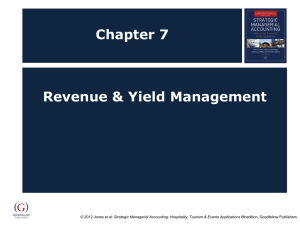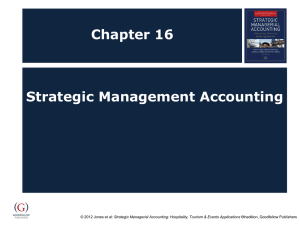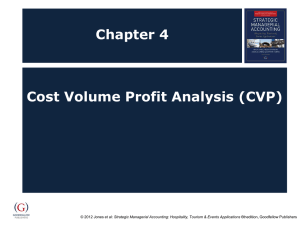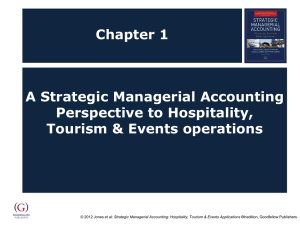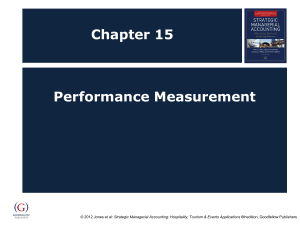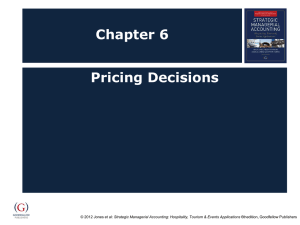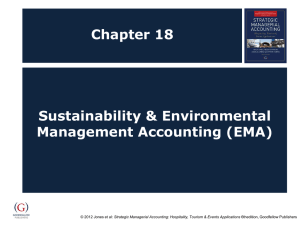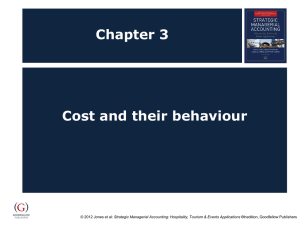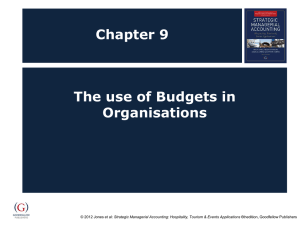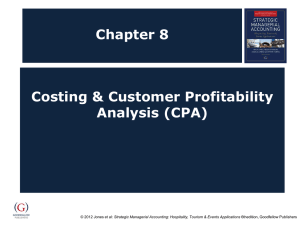Chapter 14 - Goodfellow Publishers
advertisement
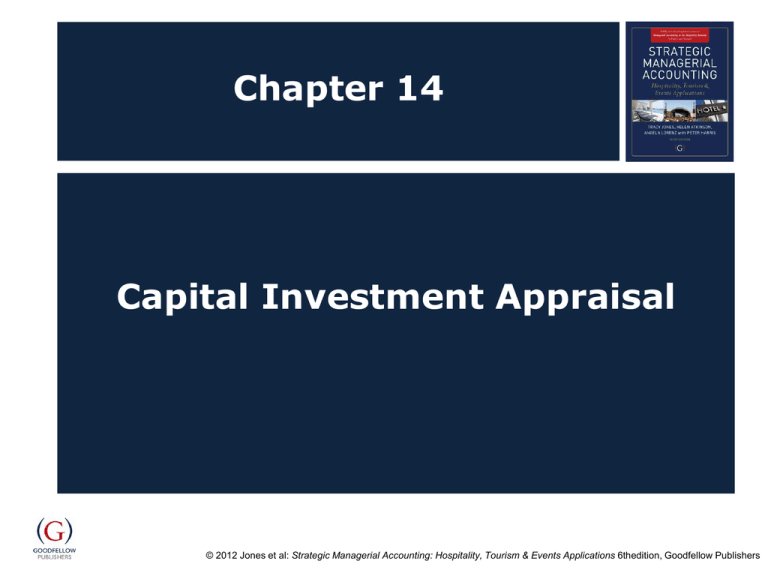
Chapter 14 Capital Investment Appraisal © 2012 Jones et al: Strategic Managerial Accounting: Hospitality, Tourism & Events Applications 6thedition, Goodfellow Publishers Objectives After studying this topic you should be able to: Understand the importance of capital investment appraisal (CIA); Develop a working knowledge of financial CIA techniques; Appreciate the ‘time value’ of money in the CIA context; and Be able to consider the strategic implications of CIA decisions. © 2012 Jones et al: Strategic Managerial Accounting: Hospitality, Tourism & Events Applications 6thedition, Goodfellow Publishers Methods Accounting rate of return Payback Period Discounted Payback period Net Present value Internal rate of return Profitability Index © 2012 Jones et al: Strategic Managerial Accounting: Hospitality, Tourism & Events Applications 6thedition, Goodfellow Publishers Example data © 2012 Jones et al: Strategic Managerial Accounting: Hospitality, Tourism & Events Applications 6thedition, Goodfellow Publishers Accounting Rate of Return (ARR) This approach calculates the average annual profit as a percentage of the average amount invested. It is the only CIA method that is based on profits; all other methods use cash flows (discussed later). It is calculated as follows: Average Annual Profit * 100 = %ARR Average Investment An alternative formula is to use ‘Initial Investment’ instead of ‘Average Investment’. Average Annual Profit * 100 = %ARR Initial Investment © 2012 Jones et al: Strategic Managerial Accounting: Hospitality, Tourism & Events Applications 6thedition, Goodfellow Publishers Accounting Rate of Return (ARR) - example © 2012 Jones et al: Strategic Managerial Accounting: Hospitality, Tourism & Events Applications 6thedition, Goodfellow Publishers Payback period (PBP) As the name suggests, this method considers how long it takes to get back in cash inflows what went out in the initial investment. © 2012 Jones et al: Strategic Managerial Accounting: Hospitality, Tourism & Events Applications 6thedition, Goodfellow Publishers Payback period (PBP) – example (1) © 2012 Jones et al: Strategic Managerial Accounting: Hospitality, Tourism & Events Applications 6thedition, Goodfellow Publishers Payback period (PBP) – example (2) © 2012 Jones et al: Strategic Managerial Accounting: Hospitality, Tourism & Events Applications 6thedition, Goodfellow Publishers The time value of money More sophisticated methods consider the time value of money – is £1 today worth the same value in 5 years time? © 2012 Jones et al: Strategic Managerial Accounting: Hospitality, Tourism & Events Applications 6thedition, Goodfellow Publishers Discounted payback period Calculated as for payback but the cash flows are discounted to reflect the time value of money. © 2012 Jones et al: Strategic Managerial Accounting: Hospitality, Tourism & Events Applications 6thedition, Goodfellow Publishers Net present value (NPV) The NPV approach allows for the time value of money, by using a set discount factor. Unlike the discounted payback period it also takes into account cash inflows over the full life of the project. Given the discount factor the rule is if the NPV value is above £0 the project is acceptable, any project with a negative NPV should be rejected. If funds are not available to fund all projects then the projects should be prioritised in the order of the maximum NPV first. © 2012 Jones et al: Strategic Managerial Accounting: Hospitality, Tourism & Events Applications 6thedition, Goodfellow Publishers Net present value (NPV) Steps: 1. Identify discount factor to be used 2. Calculate discount factor, or use tables 3. Multiple annual cash flows by discount factors 4. Total the discounted cash flows 5. If positive accept project, if negative reject © 2012 Jones et al: Strategic Managerial Accounting: Hospitality, Tourism & Events Applications 6thedition, Goodfellow Publishers Net present value (NPV) Example © 2012 Jones et al: Strategic Managerial Accounting: Hospitality, Tourism & Events Applications 6thedition, Goodfellow Publishers Internal Rate of return (IRR) IRR works in the opposite way be considering what discount rate (cost of capital) can be applied in order for the NPV to equal £0. It requires a positive and negative NPV to be calculated so the 0 point can be calculated. © 2012 Jones et al: Strategic Managerial Accounting: Hospitality, Tourism & Events Applications 6thedition, Goodfellow Publishers Internal Rate of return (IRR) example © 2012 Jones et al: Strategic Managerial Accounting: Hospitality, Tourism & Events Applications 6thedition, Goodfellow Publishers Profitability Index When ranking projects another alternative is to calculate their Profitability Index (PI). This is done by dividing the discounted inflows by the investment. Discounted Inflows Initial Investment © 2012 Jones et al: Strategic Managerial Accounting: Hospitality, Tourism & Events Applications 6thedition, Goodfellow Publishers Profitability Index example © 2012 Jones et al: Strategic Managerial Accounting: Hospitality, Tourism & Events Applications 6thedition, Goodfellow Publishers Uncertainty in investment projects Adjusting the basic cash flows. Adjusting the rate required. A higher rate may be required from projects with higher levels of risk. Use of three estimates – a high, medium and low estimated (best, expected and worse case scenarios). This gives the extreme potential results. Applying probability factors. This is a more sophisticated version of the three estimates approach, where the likelihood of each outcome is weighted into the estimates. Sensitivity analysis. This can involve looking at each aspect of the project (income and expenditure) and considering how sensitive each element is to change. For example; what if sales changed by 10%, or what if staff costs changed by 10%? © 2012 Jones et al: Strategic Managerial Accounting: Hospitality, Tourism & Events Applications 6thedition, Goodfellow Publishers Integrated strategic approaches Fit with strategic plan; Chance of negative publicity; Impact on current market position; Environmental impact; Level of risk; Project feasibility studies; Periodic review and cost comparison once projects are started; and Post-completion audit of project, lessons learned for the future. © 2012 Jones et al: Strategic Managerial Accounting: Hospitality, Tourism & Events Applications 6thedition, Goodfellow Publishers Summary Accounting rate of return is the only method to be based on profits, all others use cash flows. Payback period is a simple method, but still commonly used in organisations. Discounted Cash Flow methods consider the time value of money. Where IRR and NPV rank different projects first place the NPV should be followed. A number of integrated strategic approaches exist that integrate financial considerations with aspects of risk and strategic imperatives. © 2012 Jones et al: Strategic Managerial Accounting: Hospitality, Tourism & Events Applications 6thedition, Goodfellow Publishers
